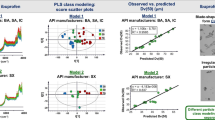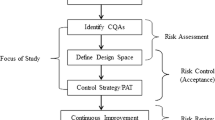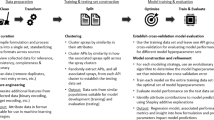Abstract
This work compares the estimation of the particle size distribution of a pharmaceutical powder using near-infrared spectroscopy (NIRS), powder flowability properties, and components concentration. The estimations were made by considering the former data blocks separately and together using a multi-block approach. The powders were based on a formulation of paracetamol as the pharmaceutical active ingredient. The reference method used to determine particle size distribution was sieving. Partial least squares methods were used to estimate the multivariate regression models, and the results were compared in terms of figures of merit. It was shown that the partial least squares methods gave similar prediction errors. Regarding the data blocks used, the NIRS block was proven the most advantageous to estimate the particle size distribution. The prediction error of the NIRS block was similar to the other data blocks with additional advantages such as less generalization problems and the possibility of its use to predict additional physical and chemical properties with an improvement to analysis time. The multi-block approach produced the worst results but nevertheless allowed a deeper understanding of the individual contributions of the data blocks in the prediction of the particle size distribution.








Similar content being viewed by others
References
Navaneethan CV, Missaghi S, Fassihi R (2005) Application of powder rheometer to determine powder flow properties and lubrication efficiency of pharmaceutical particulate systems. AAPS PharmSciTech 6:E398–E404
O’Neil AJ, Jee RD, Moffat AC (1998) The application of multiple linear regression to the measurement of the median particle size of drugs and pharmaceutical excipients by near-infrared spectroscopy. Analyst 123:2297–2302
Frake P, Gill I, Luscombe CN, Rudd DR, Waterhouse J, Jayasorriya UA (1998) Near-infrared mass median particle size determination of lactose monohydrate, evaluating several chemometric approaches. Analyst 123:2043–2046
Lee YSL, Poynter R, Podczeck F, Newton JM (2000) Development of a dual approach to assess powder flow from avalanching behavior. AAPS PharmSciTech 1:E21
Li Q, Rudolph V, Weigl B, Earl A (2004) Interparticle van der Waals force in powder flowability and compactibility. Int J Pharm 280:77–93
Bellamy LJ, Nordon A, Littlejohn D (2008) Real-time monitoring of powder mixing in a convective blender using non-invasive reflectance NIR spectrometry. Analyst 133:58–64
Blanco M, Peguero A (2008) An expeditious method for determining particle size distribution by near infrared spectroscopy: comparison of PLS2 and ANN models. Talanta 77:647–651
Maghsoodi M, Hassan-Zadeh D, Barzegar-Jalali M, Nokhodchi A, Martin G (2007) Improved compaction and packing properties of naproxen agglomerated crystals. Drug Dev Ind Pharm 33:1216–1224
Otsuka M, Mouri Y, Matsuda Y (2003) Chemometric evaluation of pharmaceutical properties of antipyrine granules by near infrared spectroscopy. AAPS PharmSciTech 4:1–7
PellowJarman MV, Hendra PJ, Lehnert RJ (1996) The dependence of Raman signal intensity on particle size for crystal powders. Vib Spectrosc 12:257–261
Otsuka M, Matsuda Y (1996) Comparative evaluation of mean particle size of bulk drug powder in pharmaceutical preparations by Fourier-transformed powder diffuse reflectance infrared spectroscopy and dissolution kinetics. J Pharm Sci 85:112–116
De Beer TRM, Baeyens WG, Vander Heyden Y, Remon JP, Vervaet C, Verpoort F (2007) Influence of particle size on the quantitative determination of salicylic acid in a pharmaceutical ointment using FT-Raman spectroscopy. Eur J Pharm Sci 30:229–235
Otsuka M (2004) Comparative particle size determination of phenacetin bulk powder by using Kubelka–Munk theory and principal component regression analysis based on near-infrared spectroscopy. Powder Technol 141:244–250
Patel S, Kaushal AM, Bansal AK (2007) Effect of particle size and compression force on compaction behavior and derived mathematical parameters of compressibility. Pharm Res 24:111–124
Berntsson O, Danielsson LG, Johansson MO, Folestad S (2000) Quantitative determination of content in binary powder mixtures using diffuse reflectance near infrared spectrometry and multivariate analysis. Anal Chim Acta 419:45–54
Gabaude CMD, Gautier JC, Saudemon P, Chulia D (2001) Validation of a new pertinent packing coefficient to estimate flow properties of pharmaceutical powders at a very early development stage, by comparison with mercury intrusion and classical flowability methods. J Mater Sci 36:1763–1773
Marriott C, MacRitchie HB, Zeng XM, Martin GP (2006) Development of a laser diffraction method for the determination of the particle size of aerosolised powder formulations. Int J Pharm 326:39–49
Simoes S, Sousa A, Figueiredo M (1996) Dissolution rate studies of pharmaceutical multisized powders—a practical approach using the Coulter method. Int J Pharm 127:283–291
Pan TS, Sevick-Muraca EM (2006) Evaluation of ingredient concentration in powders using two-speed photon migration theory and measurements. J Pharm Sci 95:530–541
Roggo Y, Chalus P, Maurer L, Lema-Martinez C, Edmond A, Jent N (2007) A review of near infrared spectroscopy and chemometrics in pharmaceutical technologies. J Pharm Biomed Anal 44:683–700
Sarraguça MC, Lopes JA (2009) Quality control of pharmaceuticals with NIR: from lab to process line. Vib Spectrosc 49:204–210
Pasikatan MC, Steele JL, Spillman CK, Haque E (2001) Near infrared reflectance spectroscopy for online particle size analysis of powders and ground materials. J Near Infrared Spectrosc 9:153–164
O’Neil AJ, Jee RD, Moffat AC (2003) Measurement of the percentage volume particle size distribution of powdered microcrystalline cellulose using reflectance near-infrared spectroscopy. Analyst 128:1326–1330
Sarraguça MC, Cruz AV, Soares SO, Amaral HR, Costa PC, Lopes JA (2010) Determination of flow properties of pharmaceutical powders by near infrared spectroscopy. J Pharm Biomed Anal 52:484–492
Tormod N, Tomas I, Fearn T, Tony D (2002) A user-friendly guide to multivariate calibration and classification. NIR, Chichester
Madariaga LF, Marchal P, Castel C, Favre E, Choplin L (2009) Characterization of impregnated particles via powder rheology. Powder Technol 196:222–228
Geladi P, Kowalski BR (1986) Partial least-squares regression—a tutorial. Anal Chim Acta 185:1–17
Miller CE (2000) Chemometrics for on-line spectroscopy applications—theory and practice. J Chemom 14:513–528
Brereton RG (2000) Introduction to multivariate calibration in analytical chemistry. Analyst 125:2125–2154
Bras LP, Bernardino SA, Lopes JA, Menezes JC (2005) Multiblock PLS as an approach to compare and combine NIR and MIR spectra in calibrations of soybean flour. Chemometr Intell Lab Syst 75:91–99
Felicio CC, Bras LP, Lopes JA, Cabrita L, Menezes JC (2005) Comparison of PLS algorithms in gasoline and monitoring with MIR and NIR. Chemometr Intell Lab Syst 78:74–80
Westerhuis JA, Kourti T, MacGregor JF (1998) Analysis of multiblock and hierarchical PCA and PLS models. J Chemom 12:301–321
Westerhuis JA, Smilde AK (2001) Deflation in multiblock PLS. J Chemom 15:485–493
Wold S, Kettaneh N, Tjessem K (1996) Hierarchical multiblock PLS and PC models for easier model interpretation and as an alternative to variable selection. J Chemom 10:463–482
Eriksson L, Johansson E, Kettaneh-Wold WC, Wold S (2000) Design of experiments: principles and applications. Umetrics AB, Umea
Acknowledgements
Mafalda C. Sarraguça acknowledges the financial support from the Fundação para a Ciência e Tecnologia (FCT), Portugal (Ph.D. grant, ref SFRH/BD/32614/2006). Ana V. Cruz acknowledges the support from the Fundação para a Ciência e Tecnologia (FCT), Portugal, through a pre-graduation grant (FCT/CEQUP/GABAI-8/2008).
Author information
Authors and Affiliations
Corresponding author
Additional information
Published in the special issue Chemometrics (VII Colloquium Chemiometricum Mediterraneum) with Guest Editors Marcelo Blanco, Juan M. Bosque-Sendra, and Luis Cuadros-Rodríguez
Rights and permissions
About this article
Cite this article
Sarraguça, M.C., Cruz, A.V., Amaral, H.R. et al. Comparison of different chemometric and analytical methods for the prediction of particle size distribution in pharmaceutical powders. Anal Bioanal Chem 399, 2137–2147 (2011). https://doi.org/10.1007/s00216-010-4230-6
Received:
Revised:
Accepted:
Published:
Issue Date:
DOI: https://doi.org/10.1007/s00216-010-4230-6




